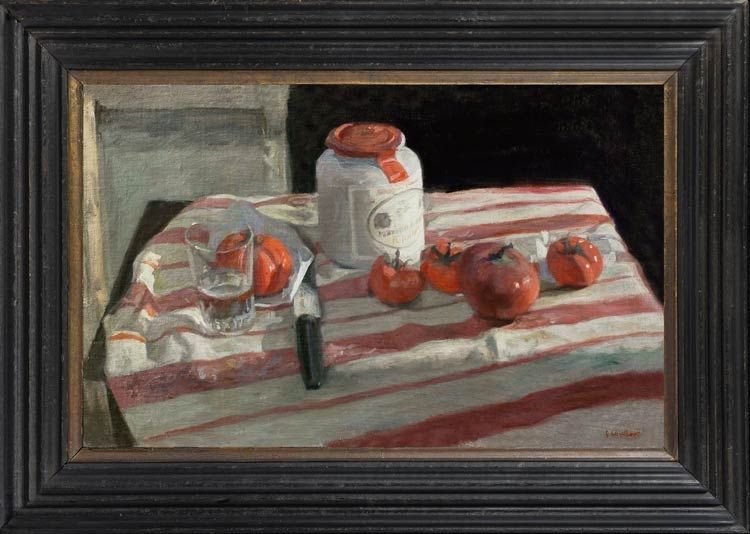In this work Weissbort is conducting one of his visual experiments: working with a limited number of colours but an immensely wide range of tones. This painting is, like the Egyptian flag, composed from red, white and black, with tiny touches of green (in the tomato stalks) and gold (on the label) to lift and animate the composition. The result, however, is far from restrained; it resonates, zings and thrums with plangent, percussive life – the scarlet tomatoes both echoing and fighting against the cooler reddish pinks of the cloth, and the white areas of cloth (with their nacreous colour reflections) separating sharply from the whites of paper and jar. The viewpoint also helps to animate the scene; its slight elevation, together with the diagonal set of the table, gives an unsettling sense of movement, as though the surface were shifting and swaying. This is the influence of Cézanne again (cf. his Compotier with pitcher & fruit, Barnes Foundation); this is still life reimagined – contemporary artefacts updated, colours set against each other, harmony and peace shaken up, the contemplative spectator made to look with fresh eyes.
Biographical details
George Weissbort (1928-2013) was born in Belgium and moved to London at the age of 7. He attended the Central School of Art & Design (now St Martin’s) where he was taught by Ruskin Spear and Rodrigo Moynihan. He was influenced by Arthur Segal to move from the abstract expressionism of the 1940s to realism, and by Bernard Meninsky, who taught life drawing at the Central School, to study the Old Masters. He turned first to artists such as Cézanne and Matisse, and later to Vermeer, Chardin, Velasquez, Corot, Titian, Holbein, and Piero della Francesca, amongst others.
He exhibited regularly at the Royal Academy, the Royal Society of Portrait Painters and the Fine Art Society. In 1964-65 he had a large exhibition in Paris, and in 2006 he had a one-man retrospective at the Chambers Gallery, London, followed in 2008 by another at the Denise Yapp Gallery, Whitebrook, Monmouth.
He wrote essays on art and criticism which look both at the techniques of making a painting, and of appreciating a work of art. The latter skill he believed came only after years of consciously training the eye to see as the artist saw, considering for example the ‘negative’ spaces around and between objects. He also discussed the work of specific artists, such as Lucien Freud and Vermeer.
His obituary in The Independent quotes Brian Sewell, a friend, as saying of him that Weissbort ‘painted the right pictures at the wrong time’. His appeal was to those who understood his models and influences; he could be described as a painter’s painter, and the same obituary quotes Paula Rego describing him as ‘a truly honest artist who knows so much about painting’.
Publications: George Weissbort, Paintings and Drawings (Parnassus, 2008), ill. 130 colour plates; includes transcripts of a filmed interview; essays by Tony Rudolph, David Lee and Bernard Dunstan RA.
YouTube video: A tribute to George Weissbort by John French.


